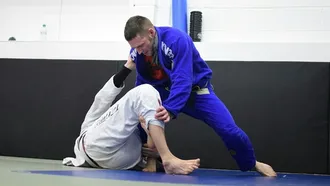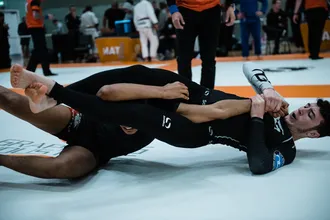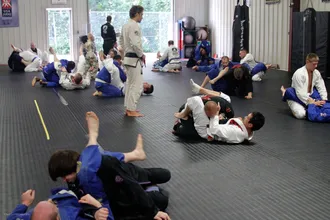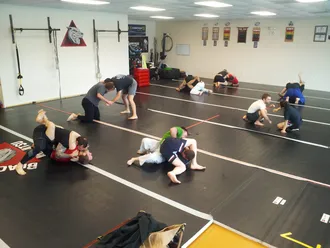
Ever wondered what separates Brazilian Jiu-Jitsu (BJJ) from Judo? Whether you're looking for the best martial art for self-defense, competition, or overall fitness, both BJJ and Judo have their strengths—but they play by very different rules.
Judo is all about throws and takedowns, built for tossing opponents onto the mat with maximum efficiency. BJJ, on the other hand, specializes in ground control and submissions, allowing smaller fighters to outmaneuver and submit larger opponents.
But which one is right for you? Do you want to dominate from the feet like a Judoka, or control the ground like a BJJ black belt?
This guide breaks down the key differences and similarities between BJJ and Judo, including their techniques, rules, and training styles. By the end, you’ll have a clear understanding of which martial art suits your goals—whether it's self-defense, MMA, or simply having fun on the mats.
- What is Brazilian Jiu-Jitsu (BJJ)?
- What is Judo?
- Similarities Between BJJ and Judo
- Key Differences Between BJJ and Judo
- FAQ
- Is Judo the same as BJJ?
- What are the key differences between BJJ and Judo?
- Is BJJ or Judo better for self-defense?
- Judo vs. BJJ for self-defense: Which is better?
- Is BJJ more effective than Judo?
- Which is harder to learn, BJJ or Judo?
- Can you train both BJJ and Judo?
- Can you use Judo throws in BJJ?
- Which is better for MMA, BJJ or Judo?
- Why is Judo not as popular as BJJ?
- Conclusion
What is Brazilian Jiu-Jitsu (BJJ)?
Brazilian Jiu-Jitsu (BJJ) is a martial art that specializes in ground fighting, positional control, and submissions. Instead of relying on strength, BJJ uses leverage, technique, and strategy to control and defeat opponents—making it effective for both sport and self-defense.
Originally adapted from Japanese Jujutsu and Judo, BJJ was refined in Brazil, particularly by the Gracie family. It evolved into a system that allows smaller fighters to outmaneuver and submit larger, stronger opponents using techniques like joint locks and chokeholds.
Today, BJJ is widely practiced worldwide, from self-defense schools to MMA training camps. It is known for its emphasis on live sparring ("rolling"), where practitioners constantly test and refine their skills in real-time scenarios.
What is Judo?
Judo, which translates to "gentle way" in Japanese, is a martial art that focuses on throws, sweeps, and grappling techniques. Instead of using strikes, Judokas use leverage and balance to off-balance and throw their opponents to the ground.
Founded in the late 19th century by Jigoro Kano, Judo was designed as a safer, more structured adaptation of traditional Japanese Jujutsu. Kano developed the system under the principle of "maximum efficiency, minimum effort", meaning that a well-executed technique can allow a smaller fighter to defeat a stronger opponent.
Today, Judo is practiced worldwide and is one of the few Olympic martial arts. It is best known for its explosive throws ("nage-waza"), which allow Judokas to dominate standing grappling exchanges, as well as its powerful pins and submissions ("ne-waza") on the ground.
BJJ vs Judo: What Do They Have in Common?
While BJJ and Judo have distinct fighting styles, they share a common foundation. Both come from Japanese Jujutsu and emphasize technique, leverage, and strategy over brute force. Whether you're throwing an opponent or controlling them on the ground, these martial arts teach efficiency in movement and control.
Beyond technique, BJJ and Judo both foster mental discipline, physical conditioning, and a global community. Let’s break down the key similarities between these two powerful grappling arts.
Shared Roots in Japanese Jujutsu
Both BJJ and Judo originate from traditional Japanese Jujutsu, a system of grappling techniques used by samurai. Judo was developed in the late 19th century by Jigoro Kano, who refined Jujutsu techniques to create a sport that emphasized throws and control. Later, Judo made its way to Brazil, where the Gracie family adapted it into Brazilian Jiu-Jitsu, putting a greater focus on ground fighting and submissions.
Technique Over Strength
One of the biggest advantages of both BJJ and Judo is their reliance on skill and leverage rather than raw power. This makes them highly effective for smaller practitioners who learn to neutralize larger opponents using positioning, timing, and momentum. Instead of relying on brute strength, both arts teach efficiency—Judo through throws and BJJ through positional control.
Effective for Self-Defense
Both Judo and BJJ are widely used in self-defense training. Judo’s emphasis on throws and takedowns allows a practitioner to quickly neutralize a threat while standing. Meanwhile, BJJ focuses on ground control and submissions, making it invaluable if a fight goes to the ground. This combination of standing and ground defense techniques makes both styles highly practical for real-world situations.
Mental Discipline and Physical Conditioning
Training in Judo and BJJ builds more than just physical skill—it develops mental toughness, patience, and problem-solving abilities. Both require practitioners to adapt to unpredictable opponents and stay calm under pressure. Physically, both styles improve cardio, flexibility, strength, and endurance, making them excellent for overall fitness.
Global Recognition and Community
Both BJJ and Judo have massive global followings. Judo is an Olympic sport practiced worldwide, while BJJ has exploded in popularity due to its success in mixed martial arts (MMA) and self-defense programs. Whether you're in Japan, Brazil, or the United States, you’ll find thriving BJJ and Judo communities where practitioners share techniques, culture, and camaraderie.
Key Differences Between BJJ and Judo
Although BJJ and Judo share common roots, they have evolved into two distinct martial arts with different strategies, rules, and techniques. Judo is primarily focused on throws and takedowns, while BJJ emphasizes ground control and submissions. Understanding these differences helps practitioners decide which style aligns better with their training goals.
Below, we explore the major differences in techniques, training methods, and competition rules between Brazilian Jiu-Jitsu and Judo.
Focus and Techniques in BJJ and Judo
The most significant difference between BJJ and Judo is their primary focus. Judo practitioners, known as Judokas, aim to throw their opponents to the ground with maximum efficiency, often using grips, sweeps, and off-balancing techniques. In contrast, BJJ practitioners, called Jiu-Jiteiros, focus on controlling opponents on the ground and applying joint locks or chokeholds to force a submission.
Brazilian Jiu-Jitsu (BJJ)
- Ground Fighting Dominance: BJJ specializes in positional control, guard play, and submissions.
- Submissions: Techniques such as chokes, armbars, and leg locks are used to force opponents to tap out.
- Guard System: BJJ incorporates a complex guard system, allowing practitioners to attack from their back.
- Positional Strategy: Fighters prioritize securing dominant positions like mount, side control, or back control before attempting submissions.
Judo
- Throws and Takedowns: Judo specializes in dynamic throws such as Seoi Nage (shoulder throw), Osoto Gari (outer leg reap), and Uchi Mata (inner thigh throw).
- Grip Fighting: Judokas use grips on the gi (uniform) to control opponents and set up throws.
- Transition to Groundwork: While Judo includes ground fighting (ne-waza), it is secondary to throws.
- Explosive Movement: Judo techniques rely on speed, timing, and force to throw an opponent decisively.
Training and Sparring
The way BJJ and Judo practitioners train also differs significantly. Judo places a strong emphasis on drilling throws and stand-up grappling, while BJJ focuses more on live rolling (ground sparring). These differences shape how practitioners develop their skills over time.
Brazilian Jiu-Jitsu (BJJ)
- Live Rolling: BJJ practitioners spend much of their training engaged in live sparring (rolling), simulating real fight scenarios.
- Positional Drills: Students practice moving through different positions (guard, mount, side control) before attempting submissions.
- Technique-Focused: BJJ training emphasizes fine details in leverage, grips, and transitions over explosive power.
Judo
- Randori (Sparring): Judo incorporates randori (free sparring), focusing on throws and standing control.
- Uchikomi (Repetition Drills): Judokas perform uchikomi (repeated throw entry drills) to perfect timing and technique.
- Emphasis on Falling Techniques: Learning proper breakfalls (ukemi) is essential for safe training.
Rules and Scoring
Competition rules in BJJ and Judo vary significantly. Judo matches are primarily won by executing a clean throw (Ippon), while BJJ matches are won by points, positional control, or submissions.
Brazilian Jiu-Jitsu (BJJ)
- Points System: BJJ competitions award points for positional control (mount, back control, sweeps).
- Submissions: A submission automatically ends a match, regardless of points.
- Guard Pulling: Unlike Judo, BJJ allows guard pulling, where a fighter can sit to the ground and begin working from their guard.
Judo
- Ippon (Full Victory): A perfect throw that lands an opponent flat on their back wins the match instantly.
- Waza-Ari (Half Points): Two Waza-Ari (successful but incomplete throws) equal one Ippon.
- Limited Ground Fighting: If a Judo match goes to the ground, competitors have a short time to attempt a pin or submission before the referee resets them.
Comparative Table: Focus and Techniques
| Key Differences | Brazilian Jiu-Jitsu (BJJ) - Ground Fighting | Judo - Throws & Takedowns |
|---|---|---|
| Primary Focus | Ground control, positional dominance, submissions | Explosive throws, standing grappling, off-balancing |
| Key Techniques | 🛡️ Guard, 🏔️ Mount, 🩸 Chokes | 🔥 Seoi-nage (shoulder throw), ⚡ Osoto-gari (outer reap) |
| Training Structure | BJJ drilling and rolling | Judo Uchikomi & Randori |
BJJ vs Judo: Training and Sparring Compared
Training and sparring are the foundation of any martial art, shaping how practitioners develop their skills and apply techniques in real scenarios. Both BJJ and Judo have distinct training methods that reflect their core strategies—BJJ emphasizes ground control and submissions, while Judo focuses on explosive throws and stand-up grappling.
Brazilian Jiu-Jitsu (BJJ)
- Live Rolling: BJJ training features extensive rolling (ground sparring), where practitioners test techniques in live, resistance-based scenarios.
- Technique Drilling: Training sessions focus on drilling submissions, escapes, and positional transitions to refine execution.
- Positional Sparring: Some sessions emphasize specific positions—such as guard passing or escaping mount—to develop specialized skills.
- Physical Conditioning: While technique is prioritized, BJJ training also incorporates flexibility, mobility, and core strength exercises to improve endurance.
Judo
- Randori (Free Sparring): Judo's equivalent to BJJ rolling is randori, a dynamic and somewhat competitive form of sparring where practitioners attempt throws in live exchanges.
- Uchikomi (Repetition Drills): This involves practicing the entry phase of a throw multiple times without completing the technique, helping to develop muscle memory.
- Ne-waza (Groundwork Training): While less emphasized than in BJJ, Judo includes ground techniques like pins, joint locks, and chokeholds, often in short bursts of training.
- Strength & Conditioning: Judo training emphasizes overall athleticism, with a focus on explosive power, balance, and grip strength.
Comparative Table: Training and Sparring
| Training Aspect | Brazilian Jiu-Jitsu (BJJ) - Ground Control | Judo - Throws & Takedowns |
|---|---|---|
| Primary Sparring Mode | 🔥 Rolling (ground fighting with live resistance) | ⚡ Randori (standing grappling and throws) |
| Key Training Focus | 🔄 Submissions, positional control, guard play | 🏋️ Throwing techniques (uchikomi), grip fighting |
| Secondary Focus | 🛡️ Positional sparring, escape training | 🤼 Newaza (groundwork), transition practice |
| Physical Conditioning | 💪 Flexibility, core strength, mobility | 🏃♂️ Strength, endurance, explosive power |
| Training Structure | 📚 Technique drilling, followed by rolling | 🔁 Uchikomi, randori, and strength training |
BJJ vs Judo: Rules and Scoring Explained
Understanding the rules and scoring systems of BJJ and Judo is crucial for both competitors and fans. Each martial art has a unique approach to victory—BJJ rewards positional control and submissions, while Judo prioritizes throws and decisive finishes.
Below, we break down how points are scored, how matches are won, and what penalties can impact the outcome of a fight.
Brazilian Jiu-Jitsu (BJJ)
- Points System: BJJ competitions award points for achieving dominant positions like guard passing, mount, or back control.
- Submissions: A match can end immediately if a competitor forces their opponent to tap out using a choke or joint lock.
- Guard Passing: Moving past the opponent’s legs into a dominant position earns points.
- Match Duration: Typically ranges from 5 to 10 minutes depending on the belt rank and competition rules.
- Penalties: Stalling, illegal grips, and disengaging can result in warnings or point deductions.
Judo
- Ippon (Full Victory): A clean throw that lands an opponent flat on their back instantly ends the match.
- Waza-ari: Awarded for an incomplete but effective throw or pinning the opponent for 10-19 seconds. Two Waza-ari equal an Ippon.
- Golden Score (Overtime): If no Ippon is scored, the match continues in sudden death until one competitor scores.
- Match Duration: Olympic Judo matches last 4 minutes with the possibility of a golden score round.
- Penalties (Shidos): Given for stalling, illegal grips, passivity, or rule infractions. Accumulating too many results in disqualification.
Comparative Table: Rules and Scoring
| Scoring Aspect | Brazilian Jiu-Jitsu (BJJ) - Ground Fighting | Judo - Throws & Takedowns |
|---|---|---|
| Primary Goal | 🔄 Submission (forcing opponent to tap out) | 🔥 Ippon (perfect throw or two Waza-ari) |
| Points System | ✅ Awarded for positional control, guard passing, sweeps | ✅ Awarded for Waza-ari (half throws) and pins |
| Winning Criteria | 🥇 Submission or highest points by match end | 🥇 Ippon, two Waza-ari, or golden score |
| Match Duration | ⏳ 5-10 minutes (varies by belt level) | ⏳ 4 minutes (Olympic rules), golden score overtime |
| Penalties | ⚠️ Stalling, illegal grips, disengaging | ⚠️ Shidos for passivity, illegal grips, false attacks |
FAQ: Common Questions About BJJ and Judo
Is Judo the same as BJJ?
No, but they share a common history. Judo was developed first and later influenced Brazilian Jiu-Jitsu. While both involve grappling and leverage-based techniques, Judo is focused on throwing, whereas BJJ specializes in ground fighting and submissions.
What are the key differences between BJJ and Judo?
Judo is centered around takedowns and throws, aiming to bring an opponent to the ground decisively. BJJ focuses more on ground fighting, control, and submissions. While both share techniques and wear a gi, their goals are different—Judo wins with throws, while BJJ focuses on winning via control or submission.
Is BJJ or Judo better for self-defense?
Both can be effective, but they work differently. Judo focuses on powerful throws, allowing you to take down an attacker quickly. BJJ specializes in ground control and submissions, helping you neutralize an opponent without relying on strikes. If you want to stay on your feet, Judo is a solid choice. If you're comfortable fighting on the ground, BJJ is highly effective.
Judo vs. BJJ for self-defense: Which is better?
Judo is great for quickly taking down an opponent with a throw, which can end a fight before it even starts. BJJ, however, is designed to help smaller opponents control and submit larger attackers on the ground. If you expect a fight to stay standing, Judo has the advantage. If it goes to the ground, BJJ is more effective.
Is BJJ more effective than Judo?
Effectiveness depends on the situation. BJJ dominates on the ground, making it ideal for grappling-heavy combat sports like MMA. Judo, however, is excellent for quickly throwing and disabling an opponent. Both are effective for self-defense and competition but serve different purposes.
Which is harder to learn, BJJ or Judo?
Judo has a steep learning curve because throws require precise timing and technique, and falling safely (ukemi) is essential. BJJ has many positions and submissions to master, but progress can feel steadier since sparring (rolling) allows for continuous practice. Judo is more physically demanding early on, while BJJ requires more long-term strategy.
Can you train both BJJ and Judo?
Yes! Many martial artists train in both because they complement each other well. Judo provides strong takedown skills, while BJJ enhances ground control and submissions. Cross-training in both gives you a well-rounded grappling skillset.
Can you use Judo throws in BJJ?
Yes! Many Judo throws are legal in BJJ, especially in gi competitions. Throws like Osoto Gari, Seoi Nage, and Uchi Mata are commonly used in BJJ to take opponents down. However, some Judo throws require modifications to avoid exposing your back in BJJ. In no-gi BJJ, wrestling-style takedowns tend to be more common.
Which is better for MMA, BJJ or Judo?
BJJ is more commonly used in MMA because most fights end up on the ground, where submissions and positional control are crucial. However, Judo can be extremely effective in MMA when used for takedowns and controlling opponents in the clinch, as seen with fighters like Ronda Rousey.
Why is Judo not as popular as BJJ?
BJJ has grown rapidly due to its strong presence in MMA and self-defense communities. Judo, while still very popular, has stricter competition rules that limit ground techniques, which some practitioners find restrictive. The rise of submission grappling and no-gi BJJ has also contributed to BJJ’s increasing global recognition.
Conclusion: The Unique Strengths of BJJ and Judo
After exploring the rich histories, techniques, and training styles of BJJ and Judo, one thing is clear—both martial arts offer invaluable skills that go beyond just fighting. BJJ’s strategic ground control and Judo’s powerful throws each contribute to self-defense, competitive sports, and mixed martial arts.
By understanding the differences in techniques, training methods, and competition rules, practitioners can appreciate the depth of each discipline. While BJJ thrives on leverage, positioning, and submissions, Judo teaches balance, explosive movement, and takedown mastery.
Ultimately, whether you step onto the mat for self-defense, sport, or personal growth, both arts cultivate mental resilience, discipline, and a sense of community. The choice isn’t about which is better—it’s about which resonates more with your goals and training style.
Whichever path you take, embracing the journey of martial arts will challenge you, empower you, and connect you with a global network of dedicated practitioners.









